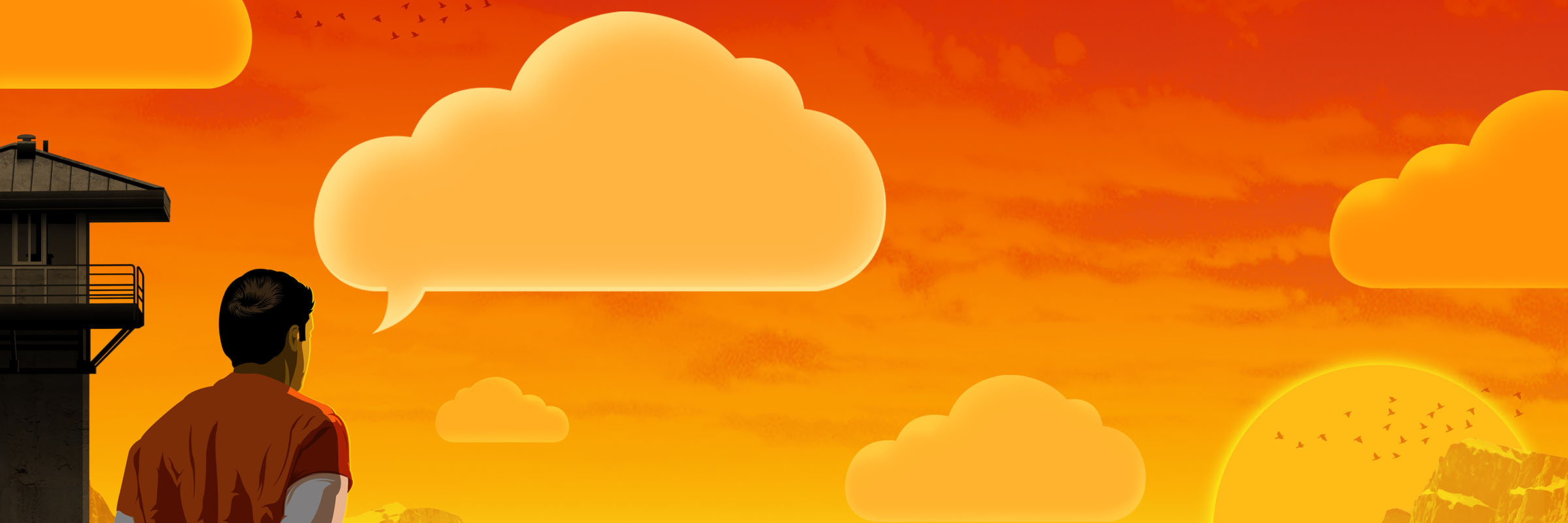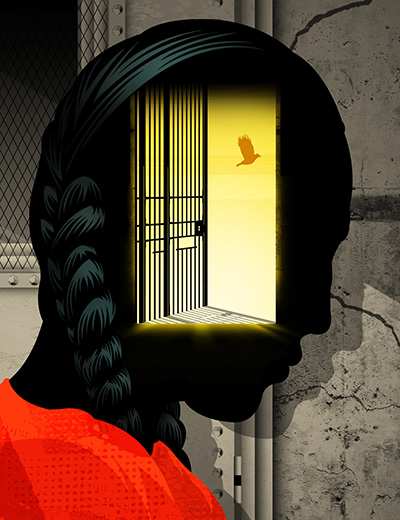Voices rarely heard
Anna Marie Sewell - 20 November 2023

STUDIES ON THE STATE OF OUR PENAL system have gone on for generations. Some things change. A shocking number of things don’t. Still, researchers return again and again to the struggle to make sense of our correctional system. After all, it is fundamental to a functioning society that we have an effective means of dealing with people who transgress the rules we have laid down for the public good. And, incarcerated or released, people who’ve done time are part of the fabric of our society.
Justin Tetrault, ’21 PhD, is a criminology professor at Augustana and has been involved with the University of Alberta Prison Project since 2016, when he was a graduate student. The heart of his work has been trying to untangle the benefits and limits of Indigenous cultural programming.
Under the leadership of principal investigator Sandra Bucerius, the project conducts research in and about Canada’s correctional institutions — our prisons. The goal of the project is to collect data on the experiences of Canadian prisoners and staff to make way for evidence-based changes. One of the most significant things the two have done is to interview, with their team, more than 600 people serving time in six men’s and women’s prisons across Western Canada.
The scope of this work is tremendous. Bucerius describes Correctional Service Canada, the government organization responsible for prisons, as “a black box,” tasked with taking care of a part of our society that most people don’t know about, and generally don’t seek to learn about. But unlocking this black box, according to both Bucerius and Tetrault, is vital for our well-being as a society.
They are not alone in their concern and academic interest. “The Prison Project started in 2016 as a mix of graduate students and professors,” Tetrault says. “I started on the project as a grad student and now I’m a professor. Initial data collection included six or eight graduate students, plus two principal investigators. Today there are about four professors and roughly the same number of grad students.” The U of A Prison Project is a broad-based investigation into experiences of inmates, and the team seeks to know the real-world impacts of programs designed not by but for the people most intimately involved.
One of the main focuses of Tetrault’s work is the impact of Indigenous cultural programs and efforts to indigenize prison structures. His work is complex. Some people say prisons are for punishment, not cultural programming. Others hold that prisons are colonial structures and nothing short of wholesale abolition of them can undo the harms of a penal system that is rooted in racist, genocidal colonial goals. But right now, prisons aren’t going anywhere. Tetrault says we must work within our present reality. He says that indigenizing the system is necessary for meeting the urgent needs and rights of imprisoned and marginalized Indigenous people.

MOST PEOPLE DON'T KNOW MUCH ABOUT our prison system. Consider the scope of Correctional Service Canada: a yearly budget of roughly $3 billion spread over a range of remand centres and prisons that house roughly 38,000 inmates. In that system, Indigenous people are proportionally over-represented, about nine times higher than the population at large can account for. A 1990s Royal Commission On Aboriginal People identified three main reasons: colonialism, socio-economic marginalization and culture clash. Maybe so, but trying to untangle the intergenerational mess that underlies this over-representation is a task far beyond the scope of this article. Still, that context informs Tetrault’s work, and that of his colleagues.
Some relevant background: since 1958, Indigenous advocates have been working to provide Indigenous inmates access to their own spiritual practices, which Canada holds to be a human right. Significantly, the Indian Act outlawed Indigenous cultural and spiritual practices in Canada until the act was revised in 1951. By the 1980s, some prisons allowed entry to elders to offer spiritual guidance and ceremonies to inmates, but what that looked like depended on the prison.
So, do cultural programs support cultural revival and Indigenous rights? Or, as prison abolitionists maintain, are these programs little more than a new form of cultural genocide, not unlike the residential school system?
Tetrault finds this debate onerous. There are no easy answers, but he is clear about a few things. “More research is needed on how prisons develop and implement cultural programming,” he says, “but existing empirical works suggest that these initiatives, while flawed, support the dignity of incarcerated Indigenous Peoples.”
An inmate named Irene (last names are excluded for privacy) spoke to the Prison Project team, and her comments are illustrative of Tetrault’s findings. “I have been incarcerated each year since [I was 19]. I wasn’t aware of much of my history, my Aboriginal social history,” she told the project team. “I’ve only learned about all that this past year through the new incorporated programs here. I am Native, I am Cree, I am from Alberta. I have participated in almost all the programs here. I’ve come from a high-risk lifestyle, violence, you name it — I’ve got nothing but guns and violence on my record. I completely turned my life around. I’m now in a traditional Pathways [indigenized] unit here living a traditional life [following cultural teachings]. I basically learned about my history and understood about colonization and residential schools and the impact thereof. I just needed to really understand how much [it impacted me] as a Native American and, um, I just don’t wanna be defined by [my past]. So I made the choice to change my ways and sober up and leave all that behind.”
THE 600-PLUS INMATES OF MEN'S AND women’s prisons interviewed by the Prison Project team represent less than 11/2 per cent of all inmates in Canada. That matters because the project team has had unprecedented scale of access to carry out their research. That 11/2 per cent is more than has ever been polled. It shows real-world information about the experiences of inmates who chose to be involved in the project. Six hundred inmates at six institutions can teach us quite a lot about their experience accessing Indigenous cultural programming.
Tetrault says that Irene’s positive experience with these programs echoes the experiences of others. “The overwhelming majority of the prisoners we interviewed spoke of Indigenous cultural programming as valuable,” Tetrault says. “If they had a complaint, it tended to be about experiencing barriers to access the programming.”
Similarly, Bucerius says, “Almost every prisoner wanted to be involved, because there is nothing else to do. It’s a sad reflection on how few programs are being offered.”
Even confining our focus to inmates’ experiences of Indigenous cultural programming, we can see the underpinnings of interconnected issues and historical circumstances that make the project’s 600 interviews seem like scratching the surface.
Tetrault is swift to point out, in person and in the publications to which he has contributed, that the work has to be understood in context: that indigenized prison programs are a human right, not a solution to mass incarceration of Indigenous Peoples.
INDIGENIZED PROGRAMS CAN INCLUDE elders visiting incarcerated people, either as volunteers or, increasingly teachings drawn from traditional Indigenous spirituality.
Elders bring their own specific culture, which might be quite distinct from the ethnic heritage of the inmates participating. Even where indigenized programming is channeled specifically toward inmates who are Indigenous, that label encompasses a continent’s worth of cultures and traditions; Haida and Maliseet culture are as distinct from each other as, say, English and Turkish; and Yellowknife to Cape Breton Island, N.S. is nearly as far as Paris to New Delhi. So “Indigenous programming” may not represent one’s own culture. But it does represent something valuable.
And it’s not only Indigenous prisoners who benefit from the programming. About 40 per cent of the incarcerated people Tetrault’s team interviewed identified as Indigenous and the rest did not. Regardless of their own ethno-cultural backgrounds, interviewees spoke about how Indigenous programs — with their emphasis on healing, restorative justice and guidance from a spirituality rooted deeply in this land — make a powerful difference in their lives.
An issue the Prison Project found is that these programs are not available to every prisoner. Services of elders are open to inmates who qualify, meaning they must be categorized as a low security risk. But an Indigenous person is more likely to be categorized as maximum security than a non-Indigenous person who commits the same crime. “The issue is that in every determining factor in moving toward their release, [Indigenous offenders] are at a distinct disadvantage,” said Todd Sloan from the Office of the Correctional Investigator of Canada in a 2001 episode of Big Picture, a CBC documentary series on conditions in prisons. Here, we learned in the episode, were programs that helped. Why not have more of them? Why not change the criteria for entry?
Nearly 20 years on, an auditor general’s report from 2019 found “disproportionately high numbers of Indigenous and Black offenders being placed in maximum security institutions.” Furthermore, the report said prison staff were 13 per cent more likely to override risk rating and place Indigenous men in higher security. The number rose to 23 per cent for Indigenous women.
Later still, in 2023, APTN Investigates: Inside Corrections interviewed correctional investigator Ivan Zinger, whose comments were similar: to take part in healing lodge programs, inmates must pass a security risk assessment. “Correctional outcomes for Indigenous people are absolutely terrible,” he said. “There are systemic barriers and biases.” These, he said, have a “detrimental impact on every single Indigenous person who is serving time in a federal penitentiary.”
This leads to another web of interlocking issues that taxes criminologists and other scholars — and sometimes pushes prevailing scholarship of Indigenous people to the position of prison abolition.

Tetrault argues that the abolitionists, while not wrong in their assessment of the impact of colonial racism in criminalizing entire segments of society, are mistaken in dismissing indigenized programs as a problematic continuation of unjust colonial policy. He finds his work in tension between the abolitionists for whom nothing short of dismantling Canada’s prison system is truly decolonial, and their opposites who see indigenized programs as pandering to people who should be punished.
A prison stay costs at least $115,000 per prisoner per year. When inmates are denied access to healing lodges, the healing lodges lose operating and maintenance funding, due to under-enrolment. “It has implications for everything,” Dominique Tremblay told APTN Investigates: Inside Corrections. Tremblay is the director general of Waseskun Healing Centre in Quebec, a healing lodge contracting with Correctional Service Canada for the rehabilitation of Indigenous men from penitentiaries and communities. “For example … we have sacred fires every day. It’s $100 for a cord of wood, if it’s 15 residents or 30 residents.” Meanwhile, incarcerated people can wait up to two years for a place in Waseskun. Sometimes it looks like indigenized programs are set up to fail.
Against this, Tetrault and the Prison Program offer the testimony of participants.
Another respondent, Olivia, spoke to the team. “I didn’t know nothing about spirituality when I first came here. And now, like, I enjoy it. I wasn’t raised in it [my culture] because I went from [foster] home to [foster] home, you know? And then living on the streets … like, nobody’s gonna be smudging while they’re getting high,” she said with a laugh. “It means working with an elder and being open to the elder’s teachings, like, from their own perspective and stuff. You do a healing plan … and smudging and being open to spirituality, praying and stuff. When I got out [of prison last time], I actually got my own smudge kit and everything. Yeah, I was that much into it!”
Irene and Olivia, and women like them, don’t find these kinds of support and teachings before they run afoul of the law. The reasons for that are, again, a society underpinned by a complex web of failings in economic, social, religious and racial history that is not easy to confront, comprehend or repair. But this, too, is the work of the U of A’s Prison Project.
LEAD RESEARCHER SANDRA BUCERIUS speaks eloquently of our society’s lack of provision for basic human needs for the most marginalized citizens, and says this lack has been expressed over and over by project participants. But here is a fact that breaks the heart: horrific though conditions in prisons might be, for the women Bucerius interviewed, prisons are sometimes the safest, best option available as living space.
Her 2020 TedX talk at the U of A, “Prison as a Temporary Refuge,” details the stories of women who admit trying to get into prison. For them, even with the cockroaches, cell counts, bullies and all, prison offers the basic human needs they cannot find outside. Other women experience homelessness and use prison to escape deadly prairie winters. This needs to change. And the Prison Project is dedicated to being part of that change.
Says Tetrault, “As a researcher, what guides me is evidence to inform policy that helps system-involved people. As an Indigenous person, what guides me are the recommendations of the Truth and Reconciliation Commission and National Inquiry into Missing and Murdered Indigenous Women and Girls. The destination might be unclear, but as researchers and advocates, we have the tools and guidance to get there.”
Critics are impatient.
"CRITICS SAY THERE ARE UNINTENDED consequences of providing Indigenous programs behind bars,” said criminologist Vicki Chartrand in a recent episode of APTN Investigates: Inside Corrections. “You have things like healing lodges — so it’s a prison, but it’s a healing lodge. The idea then is, well, if there’s all these programs for Indigenous people, and a judge is sentencing someone, they’re like, ‘maybe the best place for them is going to be a prison.’ ”
Senator Kim Pate agrees. “I think we’ve made ourselves feel better about more and more Indigenous people being in prison,” she said in the same episode.
Pate also appeared on the CBC’s Big Picture in 2001, speaking as an advocate with the Elizabeth Fry Society. “As we cut back social programs, health programs, educational programs, those people who fall through the cracks don’t fall too far,” she said. “They fall to the streets and their means of survival are criminalized.”
Tetrault, Bucerius and the Prison Project team might agree with Pate’s 2001 assessment, but not with her 2023 opinion that Indigenous programs serve to assuage guilt about colonial history and its knock-on impacts. Instead, they see cultural programming as an ongoing struggle to realize Indigenous rights inside Canada’s colonial justice system. Pate’s and Chartrand’s comments also conflict with recommendations by the Truth and Reconciliation Commission and National Inquiry into Missing and Murdered Indigenous Women and Girls, which call for more cultural support in prison and the increased use of Indigenous-led healing lodges.
At present, Tetrault, Bucerius and their colleagues on the Prison Project are at work investigating the challenges facing prisoners who have served their sentence, but who often face release with no useful, safe path in place for them to heal and be supported in their community. Tetrault says that, using their research findings, he and Bucerius hope to develop an Indigenous-led re-entry centre in downtown Edmonton, working closely with community partners.
“Getting the public to care about people in prison is challenging, especially with fears around public safety. As criminologists we try to show that people commit crimes as a response to their life circumstances, especially their environment and personal history,” Tetrault says. “This is not to excuse the actions of people in prison, but to say that if we truly care about public safety and preventing crime, we should prioritize improving people’s living conditions, including healing and rehabilitation, mental health supports and social services.”
Maybe Tetrault is an optimist. He says Canadians increasingly see incarcerated people as people, especially as problems that were once considered strictly criminal, such as drug use, are reframed as public health issues, such as addiction. “I think as researchers we have to be optimistic that our findings will contribute to change, despite the challenges.”
The more we know, the better decisions we might make. And that matters. We are all interconnected, part of the circle, to put it in terms familiar to many Indigenous people. Therefore, we have to take honest stock of where we are, in order to be sure that we are making decisions for the good of the whole circle.
And that is ultimately the role of the U of A Prison Project, to remind us that, despite the fact that we may never see them while they serve their terms, incarcerated people are irrevocably part of our circle of relations, and improving outcomes for them ultimately improves all of our lives.
This article first appeared in the Winter 2023/24 edition of the Augustana alumni magazine, Circle.